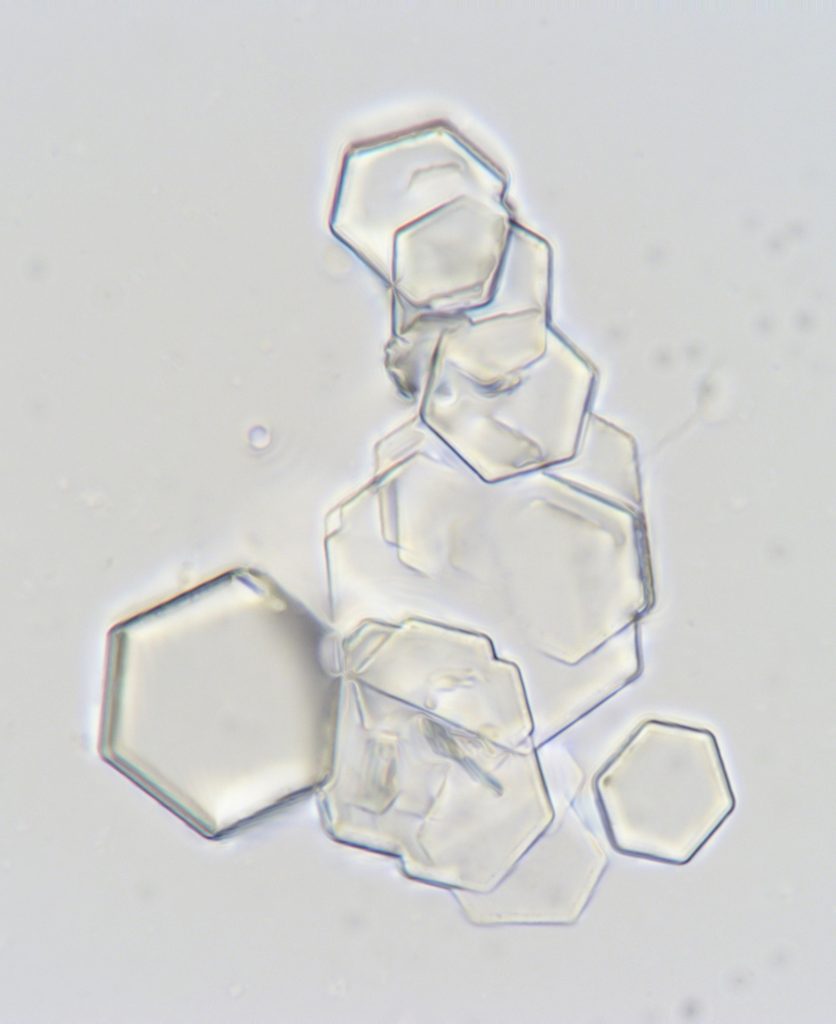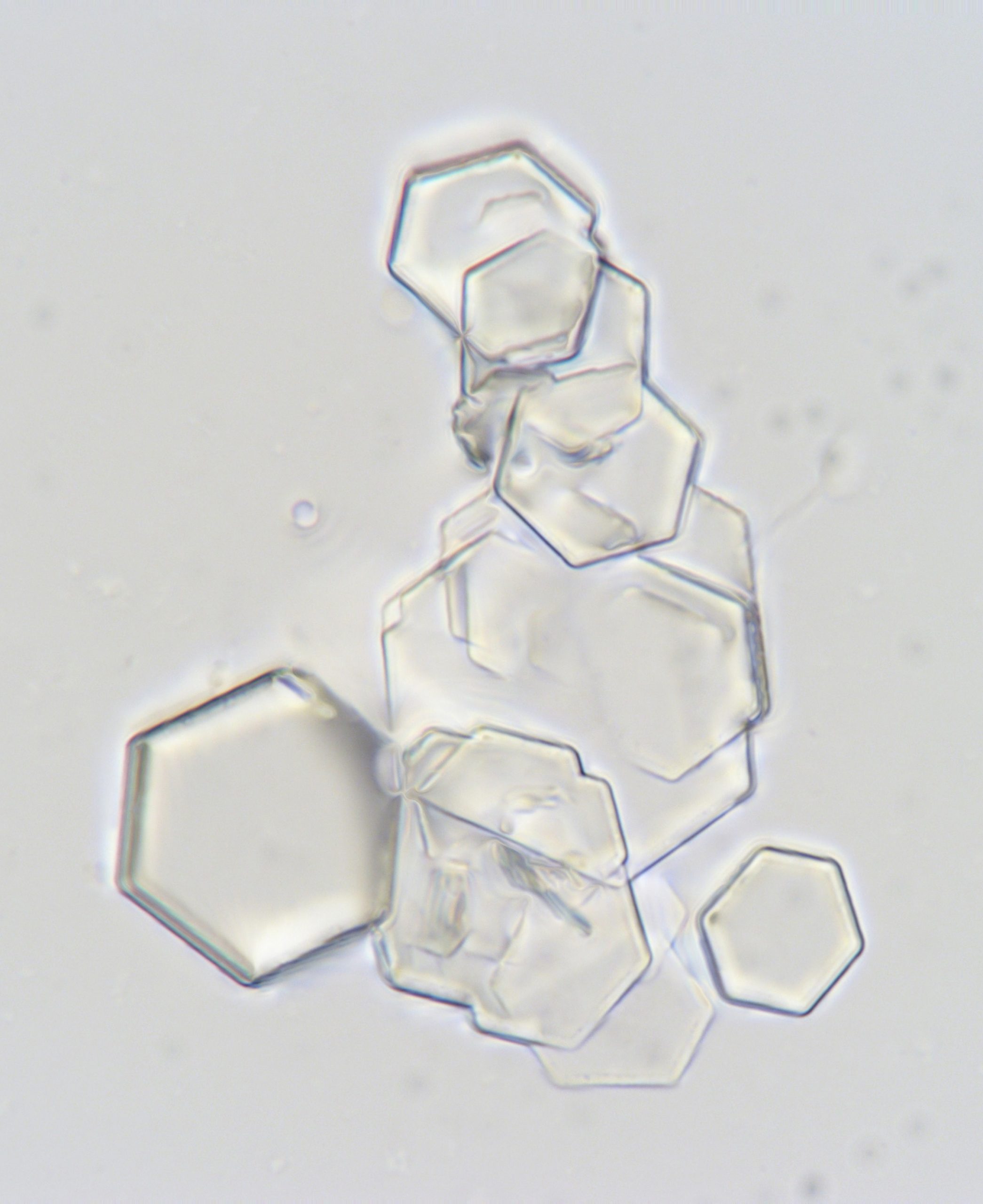– disease summary and testing options
JENNI DONALD
We have had enquiries about this condition recently and have seen cases in a Miniature Poodle, German Short-haired pointer and a Bulldog. The following is a summary of the disease and the testing options available both here and overseas.
Cystinuria is a hereditary renal transport disorder involving cystine and other dibasic amino acids—ornithine, lysine and arginine (together these are known as COLA). In normal animals, these amino acids are absorbed by the small intestine, freely filtered by the glomerulus and then >99% are reabsorbed by an active process in the proximal convoluted tubule. When tubular resorption is decreased, increased amounts of the amino acids appear in urine, but it is only cystine which causes problems. The low solubility of cystine in acidic urine can result in the formation of cystine crystals and uroliths in the urinary tract, but not all cystinuric animals will form stones. Loss of the COLA amino acids in urine has not been associated with malnutrition or protein deficiency.
Two genes, SLC3A1 and SLC7A9, have been identified as coding for the basic amino acid transporter system and its dysfunction results in cystinuria. SCL3A1 codes for the rBAT protein and SCL7A9, the bo,+AT protein and these two proteins combine to form the COLA amino acid transporter.
A severe cystinuria, referred to as Type I cystinuria, with autosomal recessive inheritance has been characterized in Newfoundlands with mutations in the SLC3A1 gene. Both males and females are affected but males tend to show more severe effects. In Newfoundlands the disease may appear earlier than in other breeds (some are <1 year of age) and uroliths can be found in the kidney as well as the more typical sites of urethra and bladder. A different mutation in the SLC3A1 gene, which is also an autosomal recessive condition, has been identified in Labrador Retrievers.
Type II cystinuria includes an autosomal dominant form described in Australian Cattle dogs (Type II-A with a deletion in SLC3A1) and a missense mutation in SLC7A9 with autosomal dominance found in Miniature Pinschers (Type II-B) in Europe. Cystinuria has also been described in many other dog breeds (at least 70) and in cross-breeds. In many, the disease occurs later in life, is less severe than the breed associated forms and only involves entire males. Surgical, and even medical castration, has been found to resolve excessive cystine and COLA excretion and this condition is now referred to as canine androgen-dependent or Type III cystinuria. Most data has come from Mastiffs, French and English Bulldogs, Basset hounds and Irish terriers, but the specific genetic defect is still not known definitively. In Mastiffs there may be a missense mutation in SLC3 A1, but this has not been found in other breeds.
Unlike canine cystine uroliths, which most commonly occur in male dogs, in cats they are seen in equal frequency in males and females, but are rare. At the Minnesota Urolith Centre, cystine uroliths make up <0.2% of stones analysed from cats. They found the mean age of cats at the time of presentation was 3.4 years (range 4 months- 12.2 years). About 65% were domestic shorthairs, 20% were Siamese and there was one Main Coon, one Korat and two domestic longhair cats. As in dogs and humans, cystinuria in cats is thought to occur from an inborn error of metabolism.

Photo by Lance Wheeler – Own work, CC BY-SA 4.0,
https://commons.wikimedia.org/w/index.php?curid=71997490
Testing for cystinuria
Urinalysis – Cystine is one of the sulphur-containing amino acids; therefore, the urine may have the characteristic odour of rotten eggs. The sediment exam may show typical flat, colourless hexagonal crystals, which are essentially pathognomonic of cystinuria. (Figure 1). The crystals tend to aggregate in the urine sediment, giving a layered appearance.
Imaging & analysis of uroliths – Cystine uroliths have intermediate radiodensity. They are less radiodense than struvites and calcium oxalates, but more so than ammonium urates. In some cases contrast studies and/or ultrasound are needed. They are typically smooth and spherical, and range from <1mm to several centimetres in diameter. Typically dogs present with multiple uroliths. Secondary urinary tract infections are uncommon. Quantitative analysis of cystine uroliths submitted to the Minnesota Urolith Center revealed that most are pure.
Urine nitroprusside test – The sodium cyanide–nitroprusside test is a rapid, simple and qualitative determination of cysteine concentrations. Cyanide converts cystine to cysteine. Nitroprusside then binds, causing a purple hue in 2-10 minutes. The test detects cysteine levels of higher than 75 mg/g of creatinine. As a qualitative test, it is not as sensitive as the quantitative tests (see COLA tests below) and not all dogs will have detectable cystine in the urine. Ampicillin- and sulphur-containing drugs in the urine may cause false-positive results. The quantitative COLA tests have generally replaced this test, however it is available at the University of Pennsylvania.
COLA quantification – These tests are performed in medical diagnostic laboratories and we have tested a few at LabPLUS, Auckland City Hospital. Concentrations of each of the four amino acids (AA), cystine, ornithine, arginine and lysine are reported as an AA:creatinine ratio, expressed as µmol of the AA/mmol creatinine. We do not have locally validated reference intervals, but references from literature can be used. At least 2mL of urine is required for testing (more is probably better) and freezing the sample is recommended if it cannot be delivered to the laboratory immediately. The cost is approximately $70 +GST, but check with your local laboratory for a current price.
This test can detect Type I and Type II cystinuric animals but not all dogs with Type III. If a positive result is obtained in dogs with Type III disease, then this test can be used following castration and for monitoring afterwards. The recommendation is to test before castration and then re-check 3-4 months after castration.
Genetic testing – Testing for recessive (Type I) cystinuria is available at various laboratories overseas for Newfoundland/Landseers and Labrador Retrievers. As it is a recessive trait, the mutation test not only detects affected dogs but also the asymptomatic carriers.
For Type II disease there are no carriers as it is autosomal dominant. An animal will therefore test clear, heterozygous affected (one copy) or homozygous affected (two copies). Tests are available overseas for Australian cattle dog and Miniature Pinscher.
Testing for canine androgen-dependent (Type III) cystinuria is more complicated. The causative mutation has not been identified but a linked marker is available that identifies risk alleles in Mastiffs and related breeds, but not Irish Terriers or Scottish Deerhounds. This test is unlikely to be applicable to other breeds and mixed breeds.
NOTES:
-The WSAVA Hereditary Disease Committee have established a web-based database of genetic tests available for hereditary diseases in dogs and cats worldwide. This is useful resource can be checked to find which laboratories do the specific tests.
–Gribbles Veterinary is no longer referring genetic testing overseas. You will need to arrange this directly with the service providers.

